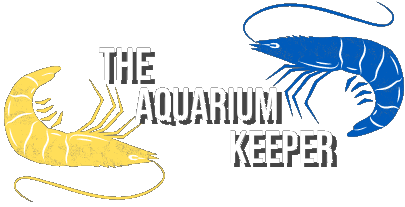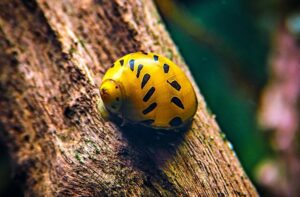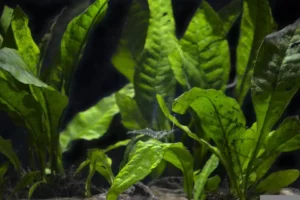
15 Amazing Honey Gourami Tank Mates

Writer at The Aquarium Keeper
Honey gourami (Trichogaster chuna), or sunset gourami is a beginner freshwater fish, that is easy to keep, and can be found in most aquarium pet shop stores. This fish is a great option to get into the fishkeeping hobby and is relatively cheap in most places.
Their natural temperament and tolerance to a wide range of water parameters make them compatible with a lot of other smaller freshwater creatures. In this article, we will break down 15 honey gourami tank mates, that will make your aquarium look amazing. Keep reading to find out more!
Honey Gourami Temperament
These fish species originate from India, Bangladesh, and Nepal. Honey gourami is typically found in lakes and rivers, and was first discovered in 1822. Honey gouramis are typically shy, and peaceful, that enjoy not being bothered but can do well with other smaller peaceful fish. It is a very hardy fish and can tolerate a lot of different water parameters, which makes honey gouramis an excellent addition to freshwater community tanks.
It can take some time for honey gouramies to adjust to their new environment, during that period they can be shy, and hide a lot. They can also live in groups, and will eventually form their own hierarchy. Some individual fish can start bullying other weaker honey gouramis, so be sure to have a lot of hiding places, and a big enough aquarium to house multiple fish.
Honey gouramis also have the ability to spit water. This unique was developed over hundreds of years, and that is how they knock down insects and flies into the water and eat them. Every honey gourami can be easily trained to spit water, which makes them a unique pet to have in an aquarium.
Honey Gourami Appearance
Like most freshwater fish species, honey gourami males are more colorful than females. Typically males have yellow, orange, and golden coloration, while females tend to be more brown and silver color. Sometimes it is hard to tell the difference between male and female honey gouramis because these species only get their coloring in the later stages of their life. While honey gouramis are juveniles, most of the time they all look the same. Another interesting thing about honey gouramis is that females are larger than males. Females usually grow up to 2 inches (5 cm) in length, while males only reach 1.5 inches (4cm).

Nevertheless, male honey gourami most of the time have a tendency to chase their female counterparts, especially in their early stages of living together. That chasing aggression usually diminishes over time. Just in case, keep male and female honey gouramis in a big enough aquarium, with a lot of plants and hiding places. Also, males are more aggressive and territorial than females, so try to keep a 1:2 male and female ratio to reduce aggression.
Honey Gourami Tank Setup
We mentioned before, that the honey gourami can be kept in a lot of different water conditions. Although this is true, it is the best practice to create the most optimal environment for this fish. While honey gourami is resilient and can tolerate a lot, it is a big responsibility as fish keepers to ensure not minimal living conditions, but the best environment.
Water Parameters
Honey gourami is a freshwater fish, that enjoys tropical water conditions. Here is a short breakdown of the most important water parameters:
- Water temperature: 21–28 °C (71–82 °F)
- pH: 6.0–7.5
- Water Hardness: 100–200 ppm
Water temperature can easily be measured with an aquarium thermometer. It is important to keep honey gouramis in the temperature range mentioned above because they just simply do best in that range. Also, ensure that the temperature does not fluctuate too suddenly, because that can stress out your fish, and it can become ill.
Water hardness and pH are also very important parameters. Most of the time, higher water hardness will mean higher pH, these two metrics are closely related to one another. Honey gourami prefers living in water that is not too hard and not too soft, and at the same time not too acidic and alkaline, so try keeping your fish in the water parameters mentioned above. Both metrics can be easily measured by a strip test kit, that can be found on Amazon.
Aquarium Size and Equipment
Even though honey gourami is not a needy and big fish, a proper size aquarium and good equipment are needed for keeping this fish species. You will need the following equipment: filter, heater, and aquarium light. In most cases, these aquarium components are not very expensive and can be found in almost any fish tank store.
Aquarium Size
The minimum tank size for a honey gourami aquarium should be at least 10 gallons (38 L), although it would only be possible to keep 1 honey gourami. If you want to keep a pair (1 male and 1 female), we would recommend 20 gallons (76 L), and if more, just add another 5 gallons for every gourami you want to keep.
Of course, if you want other fish in your aquarium besides honey gouramis, take into account that they need space too. For a small community aquarium with a pair of honey gouramis, we would recommend going with a 30-gallon (114 L) aquarium.
Filter
A filter is probably the most equipment out of all that was mentioned. It helps to clean the water, by circulating it through the part where most beneficial bacteria live, allowing it to deal with all the bad stuff fish produce. The best amount of filtration would be to buy a filter, that can circle twice the amount of your aquarium water volume per hour. If you have a 20-gallon tank, you would need a filter, that can circle 40 gallons of water per hour.
Some people have success in keeping aquarium fish without a filter, but to do this, you have to be very skilled and have to be at this hobby for a long time, because knowledge comes with time, and every small mistake can lead to fish death.
Heater
A heater is not really needed if you live in tropical weather, that stays stable throughout the year. Heaters are mostly used in aquariums, where the room temperature is colder than usual, or the region itself is cold. In unexpected circumstances, a heater can save your fish’s life, because it does not allow the water to cool down.
There is a thing that you should know about heaters. Most of them can overheat and cause significant damage to your aquarium if they are placed incorrectly. Be sure that your heater is always fully submerged in water because if it is left outside of the water, it can overheat and break down.
Aquarium Light
Lightning is very important in every aquarium, because it helps algae to grow, and some fish eat algae. At the same time, lightning replicates the natural sunlight, that every fish need, plus how are you going to see your fish without light?
The cheapest aquarium lights almost all the times are good enough, it produces enough light for your fish and aquarium plants. If you have very needy aquarium plants, we suggest getting a more advanced aquarium light.
Decorations and Substrate
It is important to have lots of decorations in your aquarium. Honey gouramis can sometimes be shy, so it is necessary that they have hiding places. You can easily use rocks, driftwood, and other decorations (castles, skulls) in your aquarium. Just be sure that you do not have decorations, that are too sharp, because all fish species are sometimes reckless, and can injure themselves.
When it comes to plants, honey gouramis love every aquatic plant. Make sure to have a lot of different aquarium plants (floating, attached to decorations, planted), because, in nature, honey gouramis live in a jungle-like dense environment, filled with different aquatic plants, so it is important to replicate that environment.
The type of substrate does not really matter for a honey gourami tank, because these species spend most of their time in the top or middle range of the aquarium. If you are going to have a lot of plants, make sure to go with the nutrient-rich substrate, it is more costly, but your plants will grow like crazy. Small rocks and sand can also be used in honey gourami tank setups, but plants will have a harder time growing.
Honey Gourami Diet
These species are not picky eaters and can eat a lot of different meals. Honey gouramis are omnivores, which means they like to eat food that has a lot of protein (insects), and sometimes they also eat plant-based food. Here is a list of things honey gourami can be fed:
- Frozen/fresh brine shrimp
- Frozen/fresh bloodworms
- Sinking pellets
- Fish flakes
- Mosquito larvae
- Algae wafers
Basic fish flakes or sinking pellets would be enough for your honey gouramis to be healthy and happy. Sometimes you can feed them brine shrimp, blood worms, and mosquito larvae as a treat. Make sure you feed your honey gouramis 1-2 times every day. Your fish should eat the food within 2-3 minutes, if they are not done by that time, it means there is too much food added to the aquarium, so make sure that you do not overfeed your fish.
Good Honey Gourami Tank Mates
After breaking down everything about honey gouramis, we can finally move on to compatible aquatic creatures for these species. The best tank mates for honey gouramis should be smaller, peaceful aquatic creatures, that can tolerate similar water parameters.
Neon Tetra
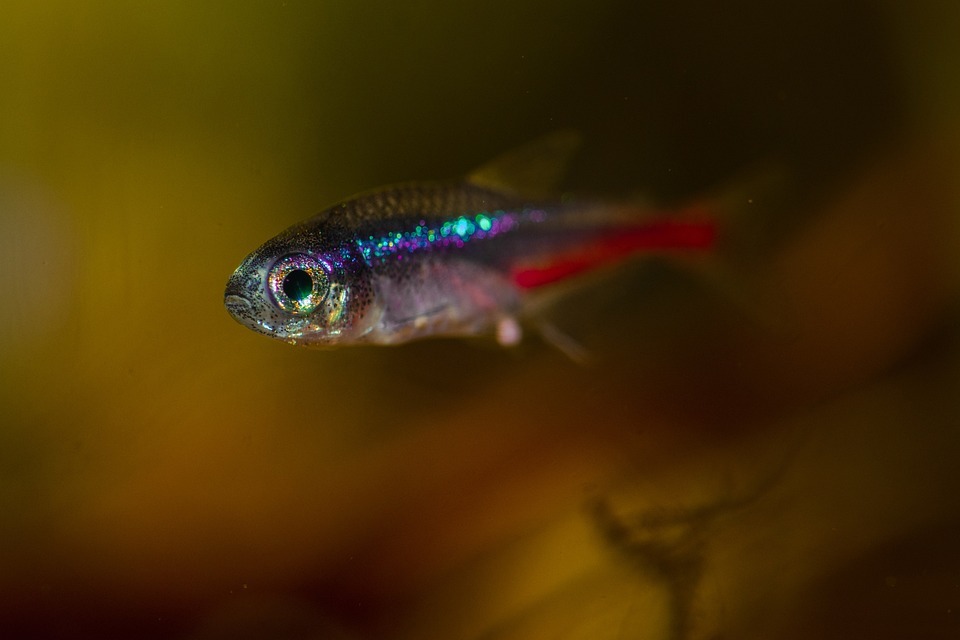
- Temperament: Peaceful
- Diet: Omnivore (fish flakes, pellets, frozen blood worms, brine shrimp)
- Size: 1.5 inches / 4 cm
- Minimum tank size: 15 gallons
- Care Level: Easy
- Desired environment: Should be kept in groups of at least 6 in a planted tank
- Life expectancy: Up to 10 years
Honey gourami and neon tetras can easily live together. Neon tetras are one of the most popular beginner aquarium fish, that can literally be found anywhere. It is a schooling species, that feels best in larger groups. They have short fins, a light blue stripe across their whole body, and some red color on their belly. Neon tetras in most cases are peaceful, but some fishkeepers noticed, that they sometimes fin-nip other fish, that have bigger fins. Neon tetras should not bother your honey gourami, because it does not have big fins and is already a shy fish.
Guppy Fish

- Temperament: Peaceful
- Diet: Omnivore (fish flakes, pellets, frozen blood worms, brine shrimp)
- Size: Males can reach 1.5 inches / 4 cm, while females can grow up to 2.5 inches / 6 cm
- Minimum tank size: 5 gallons
- Care Level: Easy
- Desired environment: Should be kept in a male-to-female ratio that is 1:2. Also a planted tank is needed for these species
- Life expectancy: Up to 2 years
Guppy fish is an excellent tank mate for honey gourami. Guppies are known for eating everything and breeding like crazy. Right now there are a lot of beautiful guppies in the aquarium industry. These species are very peaceful fish, that do not attack or harm any other aquatic creatures unless they can fit in their mouth. Guppies have a big appetite and will try to eat smaller creatures, even their own offspring.
Celestial Pearl Danio

- Temperament: Peaceful
- Diet: Omnivore (fish flakes, pellets, frozen blood worms, brine shrimp)
- Size: 1 inch / 2.5 cm
- Minimum tank size: 10 gallons
- Care Level: Moderate
- Desired environment: Should be kept in groups of at least 5 in a heavily planted tank
- Life expectancy: Up to 5 years
Celestial pearl danios or galaxy rasboras are unique-looking schooling species, that have orange or red fins, and a bunch of yellow spots throughout their body. They are relatively shy and enjoy heavily planted tanks. Celestial pearl danios can easily be honey gourami tank mates because they are not aggressive and simply avoid other bigger fish.
Pygmy Corydora
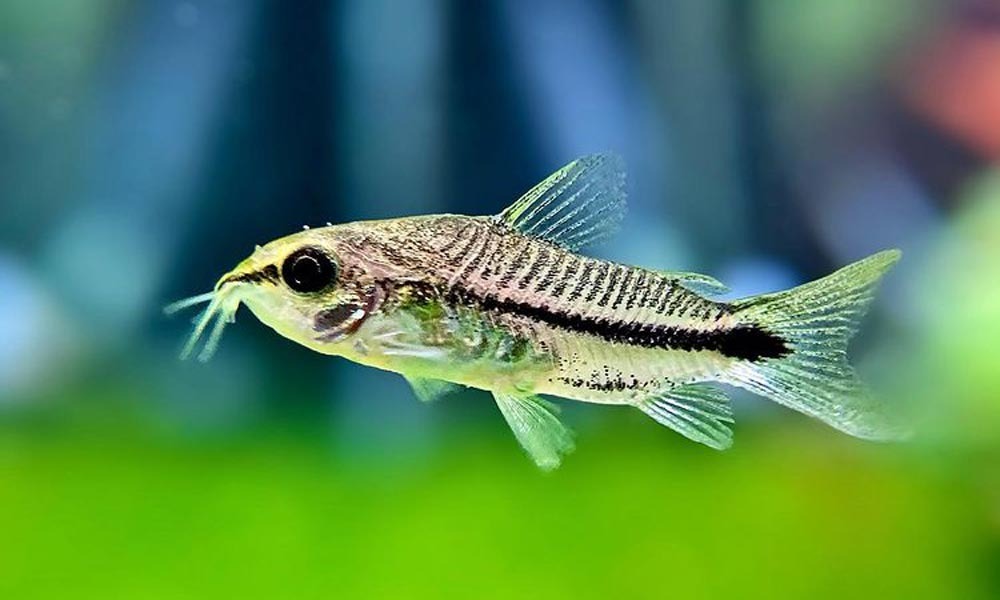
- Temperament: Peaceful
- Diet: Omnivore (algae wafers, algae, sinking pellets, bloodworms, blanched vegetables)
- Size: 1 inch / 2.5 cm
- Minimum tank size: 10 gallons
- Care Level: Easy
- Desired environment: Should be kept in groups of at least 6 in a planted tank. The best substrate for pygmy corydoras is sand
- Life expectancy: Up to 3 years
Pygmy cory catfish are amazing bottom-dwelling fish species, that are extremely peaceful. They tend to spend most of their time on the bottom of the tank, which is a good reason why pygmy corydoras would be great honey gourami tank mates. We highly suggest using sand as substrate, if you want to keep pygmies, because it is easier for them to find food on the sand, instead of rocks.
Cardinal Tetra

- Temperament: Peaceful
- Diet: Omnivore (fish flakes, pellets, frozen blood worms, brine shrimp)
- Size: 2 inches / 5 cm
- Minimum tank size: 20 gallons
- Care Level: Easy
- Desired environment: Should be kept in groups of at least 6 in a heavily planted tank
- Life expectancy: Up to 10 years
Similar to neon tetras, cardinals are another schooling fish, that tend to avoid bigger fish and feel better in larger groups of the same species. They almost look identical to neon tetras, but they have more red coloring to their belly. They are very peaceful and can easily live with honey gouramis in the same aquarium, just make sure you have a lot of plants in the tank!
Kuhli Loach

- Temperament: Peaceful
- Diet: Omnivore (sinking algae pellets, algae wafers, algae, bloodworms, blanched vegetables)
- Size: 4 inch / 10 cm
- Minimum tank size: 20 gallons
- Care Level: Easy
- Desired environment: Should be kept in groups of at least 3 in a heavily planted tank with sand substrate
- Life expectancy: Up to 14 years
Kuhli loaches are one of the shiest fish species on this list. They mainly hide all day long and only wander around the bottom of the tank at night. They can be great tank mates for honey gourami, because they are not aggressive, and they would not get in their way at all. Kuhli loaches also enjoy being with their own species, so make sure to get a few of them if you are interested.
Mystery Snail
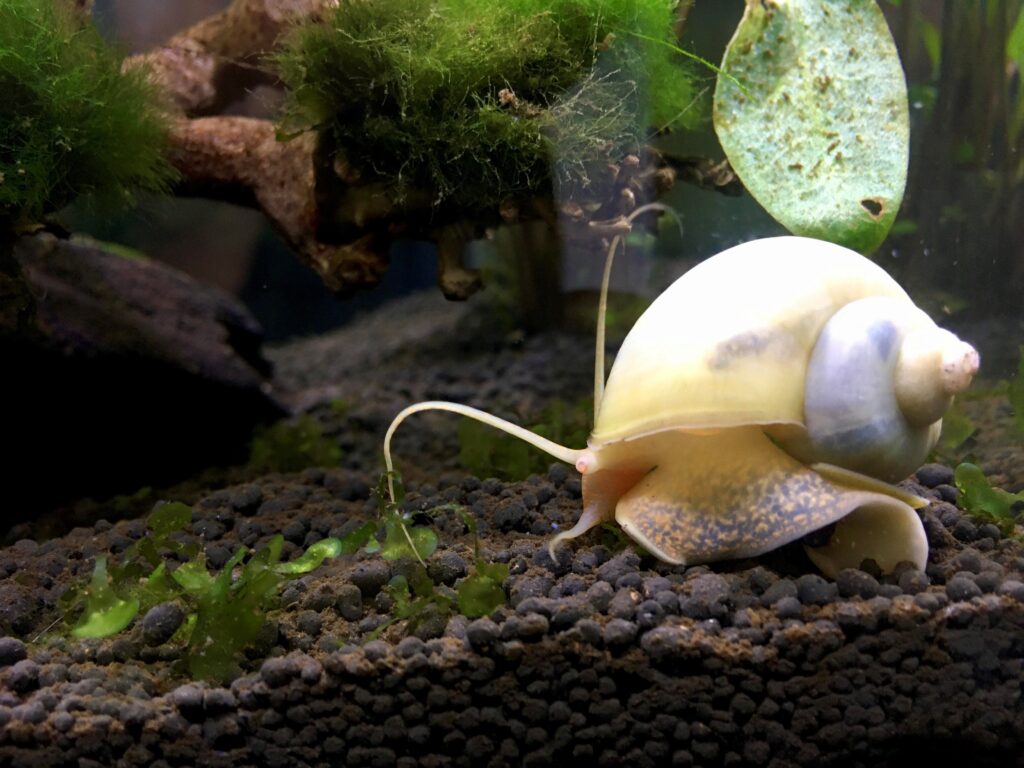
- Temperament: Peaceful
- Diet: Omnivore (leftover food, sinking pellets, algae wafers, bloodworms, blanched vegetables)
- Size: 2 inch / 5 cm
- Minimum tank size: 5 gallons
- Care Level: Easy
- Desired environment: Heavily planted tank
- Life expectancy: Up to 4 years
Snails are interesting aquatic creatures because they really do not care about fish and just go on about their own life. Mystery snails are no exception, they are amazing scavengers, that just wander around the tank, searching for food and adventure. They are also called apple snails because their shell sometimes looks similar to an apple. Mystery snails are harmless to honey gouramis, which makes them a good companion.
You might also like to read: Mystery Snail Breeding Step-by-Step Guide
Nerite Snail

- Temperament: Peaceful
- Diet: Omnivore (leftover food, sinking pellets, algae wafers, bloodworms, blanched vegetables)
- Size: 1 inch / 2.5 cm
- Minimum tank size: 5 gallons
- Care Level: Easy
- Desired environment: Heavily planted tank
- Life expectancy: Up to 2 years
Similar to mystery snails, nerites are also very peaceful creatures, that do not bother any fish. These species just wander around the aquarium, searching for food, and occasionally laying snail eggs on aquarium glass, and other decorations. Nerites come in many different colors and patterns: some snails have stripes on their shell, and others have dots or even horns. Snails in general are very good at eating algae, so consider them a good addition to your potential aquarium clean-up crew!
Chili Rasbora

- Temperament: Peaceful
- Diet: Omnivore (fish flakes, pellets, frozen blood worms, brine shrimp)
- Size: 0.75 inch / 2 cm
- Minimum tank size: 10 gallons
- Care Level: Easy
- Desired environment: Should be kept in groups of at least 6 in a heavily planted tank
- Life expectancy: Up to 8 years
Chili rasboras are the smallest nano-fish in this list, and they are very shy due to their size. Some might think that honey gouramis would see chili rasboras as food, but fear not, because these species are very small and agile, so they would not get eaten. They have bright red color to them, so your aquarium would look even better with a school of chili rasboras. Just be sure to have a lot of aquarium plants, because honey gouramis and chili rasboras are both shy species.
Molly Fish

- Temperament: Peaceful
- Diet: Omnivore (fish flakes, pellets, frozen blood worms, brine shrimp, algae)
- Size: 4-5 inches / 10-12.5 cm
- Minimum tank size: 20 gallons
- Care Level: Easy
- Desired environment: Should be kept in groups of at least 4 in a heavily planted tank
- Life expectancy: Up to 5 years
Mollies have a lot of similarities to guppies because both species are livebearers, that eat almost anything and breed like crazy. Mollies grow relatively large compared to other species on this list, but they do not have any aggressive traits and can be kept with honey gouramis. Try keeping both species in a bigger aquarium, because mollies produce a lot of waste.
Harlequin Rasbora

- Temperament: Peaceful
- Diet: Omnivore (fish flakes, pellets, frozen blood worms, brine shrimp)
- Size: 2 inch / 5 cm
- Minimum tank size: 15 gallons
- Care Level: Moderate
- Desired environment: Should be kept in groups of at least 8 in a heavily planted tank
- Life expectancy: Up to 8 years
Another peaceful schooling fish are harlequin rasboras. They can be an excellent tank companion for honey gouramis because they don’t portray any aggressive traits. Harlequin rasboras have orange bodies, with a big black spots on their body, which would make them stand out in a heavily planted aquarium.
Rummy Nose Tetra

- Temperament: Peaceful
- Diet: Omnivore (fish flakes, pellets, frozen blood worms, brine shrimp)
- Size: 1.5 inch / 5 cm
- Minimum tank size: 20 gallons
- Care Level: Easy
- Desired environment: Should be kept in groups of at least 6 in a heavily planted tank
- Life expectancy: Up to 6 years
Rummy nose tetras are probably the most beautiful species on this list (personal opinion). They have a bright red head, and a black and white tail, which makes them unique-looking, and one of the favorite schooling fish in the hobby. Rummy nose tetras are very peaceful and enjoy lots of plants. They can be excellent honey gourami tank mates, just be sure to keep these two species in a big enough aquarium, because rummy nose tetras are way larger than some species on this list.
Amano Shrimp

- Temperament: Peaceful
- Diet: Omnivore (Algae, dead plants, algae wafers, sinking pellets, blanched vegetables, blood worms)
- Size: 1 inch / 2.5 cm
- Minimum tank size: 10 gallons
- Care Level: Easy
- Desired environment: Should be kept in groups of at least 5 in a heavily planted tank
- Life expectancy: Up to 5 years
Some fish keepers might think that shrimp would instantly get eaten by honey gouramis, but amano shrimp can handle them because it is way too big to be consumed. Amano shrimp is a peaceful scavenger creature, that does not care what fish are doing. Honey gourami might try to eat it, but it would fail and eventually leave it alone. Amanos are great at dealing with algae, so they would be a good addition to a community aquarium.
Otocinclus

- Temperament: Peaceful
- Diet: Herbivore (algae, algae wafers, sinking pellets, blanched vegetables, dead plants)
- Size: 2 inch / 5 cm
- Minimum tank size: 10 gallons
- Care Level: Easy
- Desired environment: Should be kept in groups of at least 5 in a heavily planted tank
- Life expectancy: Up to 7 years
Otocincluses are very shy creatures, that spend most of their time exploring the bottom part of the tank. Unlike other species on this list, otocinclus are herbivores, which means they love eating algae, and dead plants. These species also known as “dwarf-sucking fish” can be a good honey gourami tank mate, just be sure to get a bunch of them, because they enjoy the company of their own species.
Cherry Barb

- Temperament: Peaceful
- Diet: Omnivore (fish flakes, pellets, frozen blood worms, brine shrimp)
- Size: 2 inch / 5 cm
- Minimum tank size: 30 gallons
- Care Level: Moderate
- Desired environment: Should be kept in groups of at least 5 in a heavily planted tank
- Life expectancy: Up to 7 years
Most barb species have the reputation of being notorious fin nippers, but cherry barbs are more peaceful than aggressive. Cherry barbs are another schooling fish on this list, that has a bright red color to their body. Having them in your tank would make it look way better, and they definitely can do well with honey gouramis, if there is enough space and plants.
Bad Honey Gourami Tank Mates
Some species are just incompatible, due to their size or their nature. Honey gourami can live with a lot of smaller peaceful fish, but keeping it with larger fish would be a big mistake.
Dwarf Gourami
Dwarf gourami would not do well with honey gourami in the same tank. These two species have different sizes, and their response to seeing one another would be largely dependent on their character, which is different from every fish. It would be wise not to risk keeping these two species together, simply because honey gourami is a smaller fish, and would get bullied if the dwarf gourami would decide to.
Angelfish
Angelfish is a bad choice for a honey gourami tank mate, simply because angels are too big and too aggressive. They also become more territorial during breeding times, so these two species do not work, because your honey gouramis would get injured or even killed.
Cherry Shrimp
Cherry shrimp are loved by every fish keeper, but they can’t be kept in the same tank as honey gourami. Unlike amano shrimp, cherries are too small and would get eaten by honey gouramis, so do not risk keeping these two species together.
Betta Fish
Betta fish are known for being extremely aggressive and territorial, so it is not a good idea to try to house them with honey gouramis. Although both species are the same size, either a betta fish or honey gourami would get hurt if both species entered the same aquarium.
Frequently Asked Questions
How Many Honey Gouramis Can Live in a 10-Gallon Tank?
We suggest only keeping 1 honey gourami in 10 gallons because there would be not enough space for more. These species can become stressed and aggressive if there is not enough space for them to move around.
What Fish Can be Red Honey Gourami Tank Mates?
Red honey gourami and regular honey gourami act the same, both species are very peaceful, but are just different colors. Neon tetras, Amano shrimp, harlequin rasboras, and snails can be good tank mates for red honey gourami.
Writer's Thoughts
Honey gourami is an interesting fish, that has a lot of unique traits. It can be an excellent addition to a community tank, where other smaller fish can peacefully live with honey gourami. Try giving this fish a shot, it won’t disappoint you.
If you enjoyed reading our article, please feel free to share it with your friends by clicking the social media buttons below:
